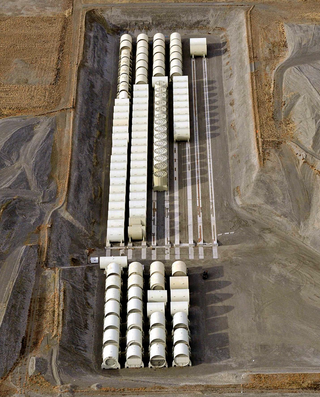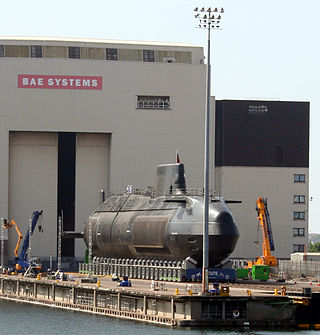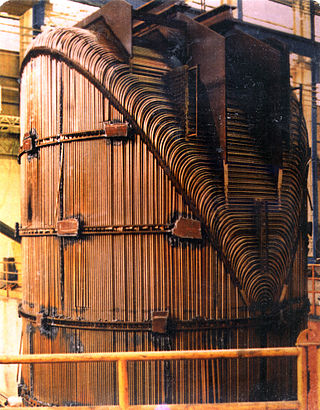
United States naval reactors are nuclear reactors used by the United States Navy aboard certain ships to generate the steam used to produce power for propulsion, electric power, catapulting airplanes in aircraft carriers, and a few minor uses. Such naval nuclear reactors have a complete power plant associated with them. All commissioned U.S. Navy submarines and supercarriers built since 1975 are nuclear powered, with the last conventional carrier, USS Kitty Hawk, being decommissioned in May 2009. The U.S. Navy also had nine nuclear-powered cruisers with such reactors, but they have since been decommissioned also.
The S1G reactor is a naval reactor used by the United States Navy to provide electricity generation and propulsion on warships. The S1G designation stands for:

A pressurized water reactor (PWR) is a type of light-water nuclear reactor. PWRs constitute the large majority of the world's nuclear power plants. In a PWR, the primary coolant (water) is pumped under high pressure to the reactor core where it is heated by the energy released by the fission of atoms. The heated, high pressure water then flows to a steam generator, where it transfers its thermal energy to lower pressure water of a secondary system where steam is generated. The steam then drives turbines, which spin an electric generator. In contrast to a boiling water reactor (BWR), pressure in the primary coolant loop prevents the water from boiling within the reactor. All light-water reactors use ordinary water as both coolant and neutron moderator. Most use anywhere from two to four vertically mounted steam generators; VVER reactors use horizontal steam generators.

USS Swordfish (SSN-579), a Skate-class nuclear-powered submarine, was the second submarine of the United States Navy named for the swordfish, a large fish with a long, swordlike beak and a high dorsal fin.
The S1C reactor was a prototype naval reactor designed for the United States Navy to provide electricity generation and propulsion on warships. The S1C designation stands for:
The S3G reactor is a naval reactor used by the United States Navy to provide electricity generation and propulsion on warships. The S3G designation stands for:

The S5G reactor was a prototype naval reactor designed for the United States Navy to provide electricity generation and propulsion on submarines. The S5G designation stands for:

The Skate-class submarines were the United States Navy's first production run of nuclear-powered submarines. They were an evolution of the Tang class in everything except their propulsion plants, which were based on the operational prototype USS Nautilus. The four Skate class boats re-introduced stern torpedo tubes. Although among the smallest nuclear-powered attack submarines ever built, the Skate class served for many years, with the last being decommissioned in 1989. USS Skate was the first submarine to surface at the North Pole, on 17 March 1959.

A nuclear submarine is a submarine powered by a nuclear reactor, but not necessarily nuclear-armed. Nuclear submarines have considerable performance advantages over "conventional" submarines. Nuclear propulsion, being completely independent of air, frees the submarine from the need to surface frequently, as is necessary for conventional submarines. The large amount of power generated by a nuclear reactor allows nuclear submarines to operate at high speed for long periods, and the long interval between refuelings grants a virtually unlimited range, making the only limits on voyage times being factors such as the need to restock food or other consumables.
The S1W reactor was the first prototype naval reactor used by the United States Navy to prove that the technology could be used for electricity generation and propulsion on submarines.

Nuclear marine propulsion is propulsion of a ship or submarine with heat provided by a nuclear reactor. The power plant heats water to produce steam for a turbine used to turn the ship's propeller through a gearbox or through an electric generator and motor. Nuclear propulsion is used primarily within naval warships such as nuclear submarines and supercarriers. A small number of experimental civil nuclear ships have been built.

The light-water reactor (LWR) is a type of thermal-neutron reactor that uses normal water, as opposed to heavy water, as both its coolant and neutron moderator; furthermore a solid form of fissile elements is used as fuel. Thermal-neutron reactors are the most common type of nuclear reactor, and light-water reactors are the most common type of thermal-neutron reactor.

The S9G reactor of the United States Navy is designed to generate electricity and propulsion for the Virginia-class attack submarines. The name S9G follows the designation scheme of platform type (submarines), generation, and the contractor.
The S5W reactor is a nuclear reactor used by the United States Navy to provide electricity generation and propulsion on warships. The S5W designation stands for:

A steam generator is a heat exchanger used to convert water into steam from heat produced in a nuclear reactor core. It is used in pressurized water reactors (PWRs), between the primary and secondary coolant loops. It is also used in liquid metal cooled reactors (LMRs), pressurized heavy-water reactors (PHWRs), and gas-cooled reactors (GCRs).

The S2G reactor was a naval reactor used by the United States Navy to provide electricity generation and propulsion on warships, and the only liquid metal cooled reactor yet deployed by the US Navy. The S2G designation stands for:
The S2W reactor was a naval reactor built by Westinghouse used by the United States Navy to provide electricity generation and propulsion on warships.

The S4W reactor was a naval reactor plant used by the United States Navy to provide electricity generation and propulsion on warships. The S4W designation stands for:
The United States Navy Nuclear Propulsion community consists of Naval Officers and Enlisted members who are specially trained to run and maintain the nuclear reactors that power the submarines and aircraft carriers of the United States Navy. Operating more than 80 nuclear-powered ships, the United States Navy is currently the largest naval force in the world.











